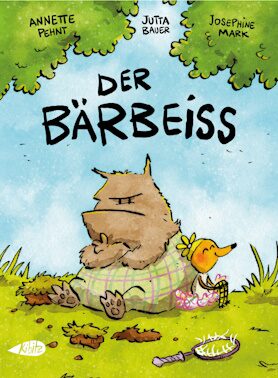Annette PehntJutta BauerJosephine Mark
Der Bärbeiss
[Der Bärbeiss]
- Kibitz Verlag
- Hamburg 2024
- ISBN 978-3-948690-27-4
- 96 Pages
- Publisher’s contact details
Italian rights already sold.
How to take a grouch in hand
More than a decade ago the author Annette Pehnt created adorable stories about a type often encountered in these parts: the Grouch. The Grouch is a corpulent, furry creature reminiscent of a grumpy bear, always bad-tempered, always expecting the worst of his fellow-creatures, and accordingly mistrustful, reclusive and irascible. From his catlike ears and vicious fangs right through to his sharp claws he is a pretty insufferable fellow.
Back then the illustrator Jutta Bauer so graphically depicted him and the tiny community in which he lived that readers could readily think themselves reflected in this world – for instance in the form of one of its affable, whimsical inhabitants such as the ever-helpful, ever-cheerful mouse-like character Tingeli, or one of the charming bunnies in the frolicsome rabbit gang, or an enterprising young heron, or even a frock-coated smart-aleck penguin, a born worrier. One would not have wanted to identify with the Grouch, however, even though some of his quirks seemed all too familiar and it gradually became apparent that hidden away in this grumpy character was a kind heart.
Then when the illustrator and graphic artist Josephine Mark, winner of the 2022 Max and Moritz Prize for ‘best comic book’ for her Trip mit Tropf [‘A trip with a drip’], came along and teamed up with Pehnt and Bauer to create a comic book out of the material that the duo had so wittily devised, what could possibly go wrong? With the various episodes now concentrated into just four distinct stories, the Grouch seems even more vividly alive than he already was before. Not only do we perceive the emotional states of the little village’s denizens as we read the book and absorb the flow of illustrations, but we can follow every successive evolution of their emotions image by image, almost as if in a perfectly contrived cartoon film. Every single sequence characterises and caricatures with immense subtlety whatever emotion the figures are feeling at that moment. The entire village community is constantly in a tizzy once the Grouch has moved into the racoon’s old house with its totally neglected garden. Compared to the paradisal little garden of his next-door neighbour Tingeli, the Grouch’s property looks like a barren wilderness to be avoided at all costs.
Even just considered on their own, the different facial expressions worn by the Grouch and Tingeli, his most doughty opponent, make for a delightful and revealing read. Jürgen Habermas would have been proud of the way kind-hearted Tingeli deploys all her communicative gifts in trying to get her shrewish neighbour to appreciate the pleasures of existence and the benefits of communal interchange and togetherness. We feel like calling out to her, ‘Don’t let yourself be provoked by the grumpy habits and doings of this complete prat’, rather as we similarly advised the poor put-upon rabbit in his altercations with the grumpy wolf in Trip mit Tropf: ‘Stick up for your imagination and stick up for the tiny little delicately coloured winged creatures that visit the garden once a year and light up the trees at night!’
The way that Josephine Mark uses a minimum of simple brush strokes to convey a multiplicity of emotions through her depiction of the characters’ mouths, eyes and foreheads – especially in the context of the arguments between Tingeli and the Grouch – betrays superb comic artistry. And in her use of words Annette Pehnt fully measures up to the quality of Mark’s illustrations. The prosaic tenor of the original story is replaced by short, pithy sentences that perfectly fill out the speech bubbles, and which – complemented by the characters and their delicately coloured milieu of gently rolling hills – summon up a readily surveyable imaginative world that the reader takes delight in inhabiting.
As was already the case in Trip mit Tropf, we wander through these stories as though we were on a woodland walk and suddenly found ourselves taken up into a parallel universe that brings our own familiar inner imaginative world to life, and shows us in a pleasant and readily comprehensible manner what magical conjurations are necessary in order to transform the grouches of our own acquaintance – and not least us ourselves – into agreeable companions.
Translated by John Reddick

By Siggi Seuß
Siggi Seuß, freelance journalist, radio script writer and translator, has been writing reviews of books for children and young people for many years.
Publisher's Summary
The inscription ‘Grouch’ recently appeared on the nameplate of the racoons’ venerable old house, written in spidery writing. But no one has yet caught sight of their new neighbour, and so, led by the particularly people-friendly villager known as Tingeli, the inhabitants of the village decide to pay this Mr Grouch a visit. After all, there’s nothing better than having lots of friends!
But this provokes Mr Grouch into a volley of vituperations: ‘Muddy puddles! Dank fog! Rotting fish! Phlegmy cough!’ - and with that he slams his door in the visitors’ faces. But Tingeli is not so easily put off. By showing cheerfulness and friendliness they will surely succeed in getting round the miserable old grouch. It’s just so silly that he doesn’t want anyone upsetting his foul mood.
Inspired by Annette Pehnt und Jutta Bauer’s Mr Grouch stories, Josephine Mark has created delightful illustrations full of profound and well-targeted humour and a deep sympathy for combative outsiders.
(Text: Kibitz Verlag)
